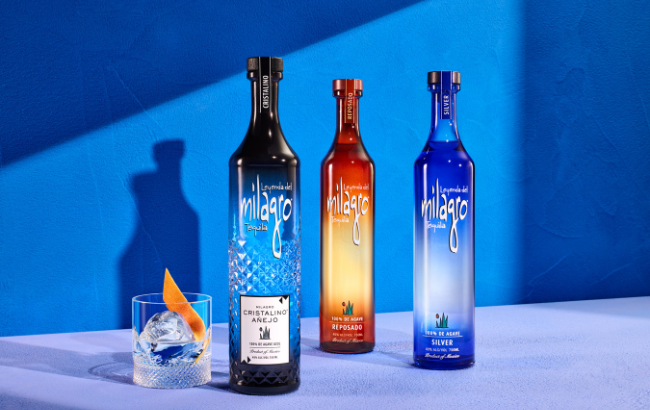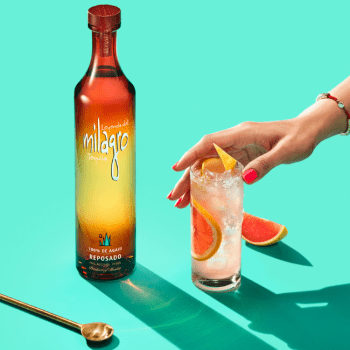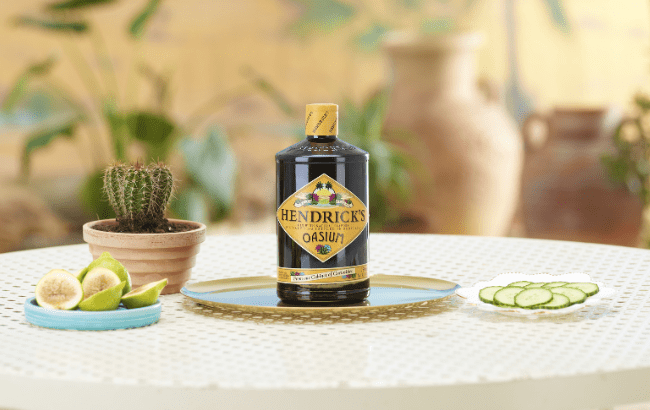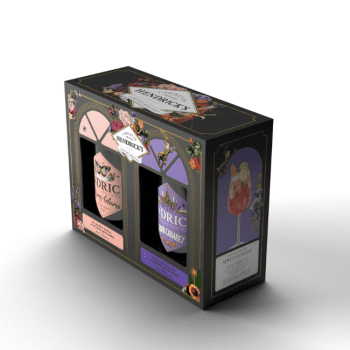Milagro Tequila nears 1m cases
By Rupert HohwielerWilliam Grant & Sons-owned Milagro Tequila is close to reaching one million cases annually after growing by double digits.

William Grant & Sons’ vice-president of marketing for mixable spirits, Michael Giardina, spoke of the Scottish company’s strategy for Milagro Tequila and Hendrick’s Gin.
Giardina is tasked with driving growth for William Grant & Sons’ two biggest non-whisky brands, Hendrick’s Gin and Milagro Tequila. Hendrick’s is at the forefront of craft gin, while Milagro is said to be the one of the fastest-growing premium Tequila brands in the US, also the only spirits category in growth in the US.
Giardina developed the brand positioning for Milagro, which has gone on to become one of the fastest-growing premium Tequilas in the US. According to Nielson data for the year ending 26 April 2025, the brand grew its value ahead of the category and key premium competitors by 7%.
Milagro is also on the cusp of selling one million cases annually after double-digit growth for the past five years.
Will it be part of The Spirits Business’s Brand Champions report next year?
“Milagro in the US, we are right around the one million case mark. We’re fighting for it, the market is slowing down, it’s getting harder, but we’re certainly fighting for it and we’ll be there probably in the next year I imagine.”
Citing IWSR data, Giardina says the brand is “one of the fastest-growing premium reposados” with Milagro reposado soaring by 63% in 2024 versus 2023.
In October 2020, William Grant & Sons acquired a distillery in Mexico to support the growth of Milagro Tequila.
Tequila is “humongous” as Giardina says, and the US market is already crammed with brands that uphold quality liquid with compelling backstories, so how is Milagro standing out in a space that’s so hot?
Inspired by Mexico
In terms of the approach to market Milagro, Giardina says: “We’re not a celebrity brand, we’re an authentic Tequila. Milagro was made years ago by two college kids who, when they looked at Tequila at that time, the impressions of Mexico really from the US side of things, Cancun party beach, like Señor Frog’s – these kids lived in Mexico City, in this incredibly culturally rich place that was modern, and the Tequilas they love was 100% Blue agave and bright and fresh and agave-forward.
“That’s what they wanted to show the world, both that side of Tequila and that side of Mexico, inspired by the energy, the vibrancy of where they’re from – so that’s why they created Milagro.
“Everything about Milagro stems from that and we stay true to that in our marketing and how we build the brand through experiences that bring their Mexico to life, and that kind of energy and atmosphere in everything we do.”
While Milagro isn’t a celebrity Tequila, Giardina doesn’t dismiss these brands and in fact thinks they’ve been key to the category’s growth in the US and further afield.
“Tequila has been a popular category for many years in the US and premiumised many, many years ago, but I think the recent explosion has been a combination. You’ve had a lot of celebrities come in, which is great in terms of bringing broader awareness to the category.
“It’s brought new people into the category who then realised that this is a really good, well-made spirit. It’s very versatile where you can put it in Margaritas, take shots with it, or sip it neat as you get into reposado and añejo. So it spans a lot of different occasions and has a lot of different usage, covering white spirits occasions to typical cocktail shot occasions to brown spirits occasions. That’s part of what’s driving the popularity.”
Of celebrity Tequilas, he says “some are better than others”, but they were great for drawing attention to the category and “are still great” for bringing more people in.
“As people come into the category, they see it and they want to explore, right? They’re led by their own experiences and tastes, and they’re looking for authentic, genuine, unique products. Not to say that some celebrities brands aren’t – some certainly are, others maybe less so – but that’s what they’re looking for now, as they come in and they explore, and they kind of gravitate to those things that align with their beliefs and their needs.”

Giardina says Milagro falls into this category, noting that its bottle “stands out” as it pays homage to where the brand comes from.
“Our bottle is inspired by the modern architecture of Mexico City and the street art.”
Looking outside of the US (the category’s biggest market), he believes the spirit is coming into its own.
“Tequila wasn’t even a category in other countries forever, other than the party, low-quality shot. It’s now just starting to grow and expand,” he says, noting growth in Australia and the UK.
“We’re seeing it in other places around the world. Canada, obviously, is pretty close,” he adds. “It’s always been big in Mexico, but still not to the scale of the US.
“So we’re starting to see it pop up and grow in other places, which is great. And I think there’s a lot of runway for it, for the category.”
Move into cristalino
The brand also got on the cristalino train last year, releasing the expression in September, which marked the brand’s first new launch in a decade.
Milagro’s cristalino is an anejo aged for 18-24 months in American and French oak casks, married together, and then charcoal filtered.
Giardino says: “Even though you’re going to get those big vanillas and a lot of flavours you get in cristalino through that filtration process, the agave is still there, and you still taste the agave. We were able to achieve that.
“I also don’t think anybody uses French oak, to my knowledge, so that’s somewhat unique as well.”
Cristalino is a big category in Mexico but it’s still relatively new in the US. “It’s been growing in high double digits for several years,” Giardina says, from a small base.
Giardina notes that the expression can fit into different occasions for Tequila, such as a twist on an Espresso Martini. “It’s in some of the top bars in the US, where we clarify the cocktail so it comes out completely clear, like a Martini, but it has all the flavours of an Espresso Martini.”
“It plays off the cristalino, which is a lot of fun,” Giardina says of the cocktail. “It’s delicious and it sells incredibly, and the cristalino actually gives it more of those vanilla flavours that go really well with the espresso.”

Hendrick’s sees growth in US
Gin’s dip since its boom in the late 2000s has been well-documented, but with flavour innovations and a focus on experiences, Hendrick’s is spearheading growth for the category.
Looking at IWSR 2024 figures in the US, the gin category declined by 5.3%, but super-premium gin was up by a slight 0.74%. Hendricks grew by 4.2% and makes up 49% of super-premium gin in the US.
Gin can pull between flavoured expressions on one end and the classic London Dry on the other, but Hendrick’s plays it down the middle to an extent.
The brand’s Cabinets of Curiosity series for example aren’t ‘flavoured’ gin in the sense that they’re still real, craft gins just made with tweaks to the botanical mix that uses Hendrick’s as its base.
“They’re taking you in a different flavour direction, without being a ‘flavoured gin’, so they’re still authentic and real,” Giardina says.
“I think that’s an important difference, because our consumers are looking, or they want, especially when you’re looking at super-premium-and-above price points, those authentic, genuine, real products.”
The Cabinet of Curiosities series has six releases to date, with one launching each year.
Giardina says this keeps gin fresh and exciting. “It keeps consumers coming back, looking forward to what’s next and what’s new,” he says.
The series’ sixth and latest wonder, named Oasium, was unveiled earlier in spring. The release drew inspiration from master distiller Lesley Gracie’s ‘curious expedition’ to a desert oasis.
“She actually took a trip to the desert and actually did play camel polo,” he confirms. “Afterwards they had this oasis area where they relaxed and there were herbs and fruits and things, and that was the influence for the gin.
“So there’s the liquid profile where we’re trying to explore different flavours, but there’s also the story behind it – and both of those things have appeal to consumers. Consumers really are looking to experiment, they want new flavours and that also expresses and reinforces our craftsmanship.
“Luckily Hendrick’s was one of the original, if not the original, craft gins as part of the craft cocktail movement. It’s been around for a while, so this reinforces our distilling craft roots, but also the storytelling aspect is one of the things people enjoy now, right? And we can bring that to life in marketing and with how people experience the brand.”
Growing gin worldwide
Although the US is the third-biggest market for gin (after the Philippines and Nigeria), Giardina advocates for other parts of the world too.
“I know Italy is a very big market for us, and gin’s been doing very well with the Spritz culture over there. There’s opportunity in some of the Asian markets like India and Philippines, and gin as a total category is growing very strongly there. Even certain Latam [Latin America] markets offer opportunities. There are opportunities around the world right now.”
IWSR data showed gin volumes grew by 2% globally last year, led by emerging markets such as Italy and India, while the UK and the US continued to decline.
Giardina also maintains the UK is still an important market, despite its decrease in recent years.
“I know that the gin category has been through some big ups and downs there, but it’s still a very important market for gin, and for Hendrick’s as a whole,” Giardina says. “We’re certainly not walking away from that market – it’s an important market.”
Long story short, he says: “I think as demographics change, as people are making more money, the emerging economy is getting more discretionary income, it just opens up opportunities around the world. They have more access to information, to trends like craft cocktail culture and things like that – and we’re seeing the result.”
Giardina also feels that even though premiumisation has subdued a bit thanks to tariff threats and economic volatility, it is still a trend, which works in Hendrick’s favour.
He explains: “It’s still a trend and Hendrick’s within gin is leading that trend. We’re the number one super-premium gin [in the US] – we’re bigger than every other super-premium gin combined.
“Even though the total category is declining, it’s being driven by a lot of the value in standard brands and when you look at super-premium-and-above, even though it’s a smaller overall chunk of the pie, it is growing.
“Hendrick’s is really driving that growth, so there’s still this opportunity if you’re positioned the right way and you’re meeting the needs of today’s consumer.”
Gin’s travel retail potential
The series also taps into the global travel retail (GTR) space where consumers might be more likely to switch up their usual spirits purchase. Amazonia, inspired by a trip Gracie took in the Amazon, and Sunspell, inspired by the sunset behind the island of Ailsa Craig on the South Ayrshire coast of Scotland, are both airport exclusives.

Giardina says the strategy is similar for these releases, but it’s just in a different channel.
He says: “I think people usually go to GTR for a better deal, or on a cost level. So with say whisky, you can kind of play around with that a little bit more. From a gin perspective, those unique kinds of offerings are the draw. If you’re into gin and you want to explore, that’s the only place that you can get these expressions. They’re not sold in any market, anywhere other than GTR.”
In terms of new releases coming down the pipeline, Giardina isn’t able to discuss those, but Hendrick’s has done a dual pack for Cabinet of Curiosities, the first time the brand has done so for the series.
The combo pack brings together two of the series’ older editions: Grand Cabaret and Flora Adora.
“They are limited edition releases, there for a year, and then they’re out.
“Flora Adora is inspired by pollen, Leslie has big gardens at [the Hendrick’s] Gin Palace. She was inspired by butterflies, bees, things that pollinate the flowers, so she looked at those plants and botanicals to create the flavour profiles for Flora.
“Grand Cabaret was inspired by 20th century Parisian cocktail culture, and there was this kind of fruit-based, not necessarily flavoured but fruity tasting cocktail that they used to drink at the time that inspired its creation, which is full of stone fruit flavours. If you could drink a gin neat, this is one of those.
“So we have that coming out in the US as a dual pack, which we’ve never done before.”
Glenfiddich owner William Grant & Sons recently reported a 30% profit decrease in 2024 and a 6.5% revenue drop to £1.83 billion (US$2.46bn).
Related news
Top 10 marketing moves from November 2025
